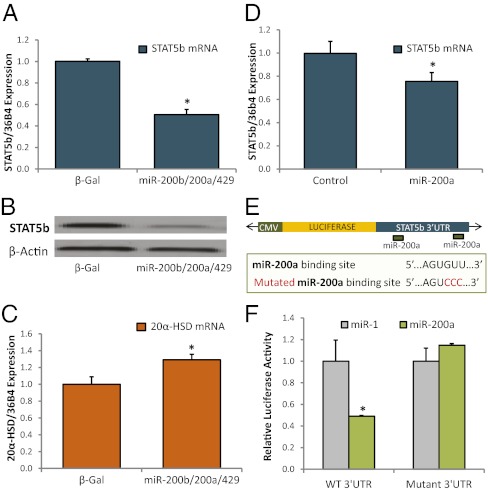Fig. 3.
miR-200s directly target STAT5b and inhibit 20α-HSD expression in human myometrial cells. (A–C) hTERT-HM cells were infected overnight with recombinant adenoviruses expressing the miR-200b-200a-429 cluster. After 72 h, miR-200 family overexpression inhibited STAT5b mRNA (A) and protein (B) and increased 20α-HSD mRNA (C) levels. (D) Transfection of hTERTs with miR-200a mimics also caused a significant reduction in STAT5b mRNA expression. Data shown in A, C, and D are the mean ± SD of values from three independent experiments, each conducted in triplicate. *Significantly (P < 0.05) different from control or β-Gal. (E) Schematic diagram of luciferase reporter containing the subcloned 3′ UTR of STAT5b with miR-200a binding sites. Wild-type and mutated binding site sequences are also shown. (F) Luciferase assays were conducted in COS7 cells cotransfected with either miR-200a or miR-1 (as control) mimics and the luciferase:STAT5b-3′ UTR reporter containing WT or mutant miR-200 binding sites. Luciferase activity in cells cotransfected with miR-200a are plotted relative to miR-1, which had no effect on reporter activity and was assigned an arbitrary value of “1.” Values are the mean ± SD of three independent experiments, each conducted in triplicate. *Significantly (P < 0.05) different from cells cotransfected with miR-1. Cotransfection data indicate that miR-200a directly targets the STAT5b 3′ UTR. Repression was lost when the putative miR-200a binding sites were mutated.

